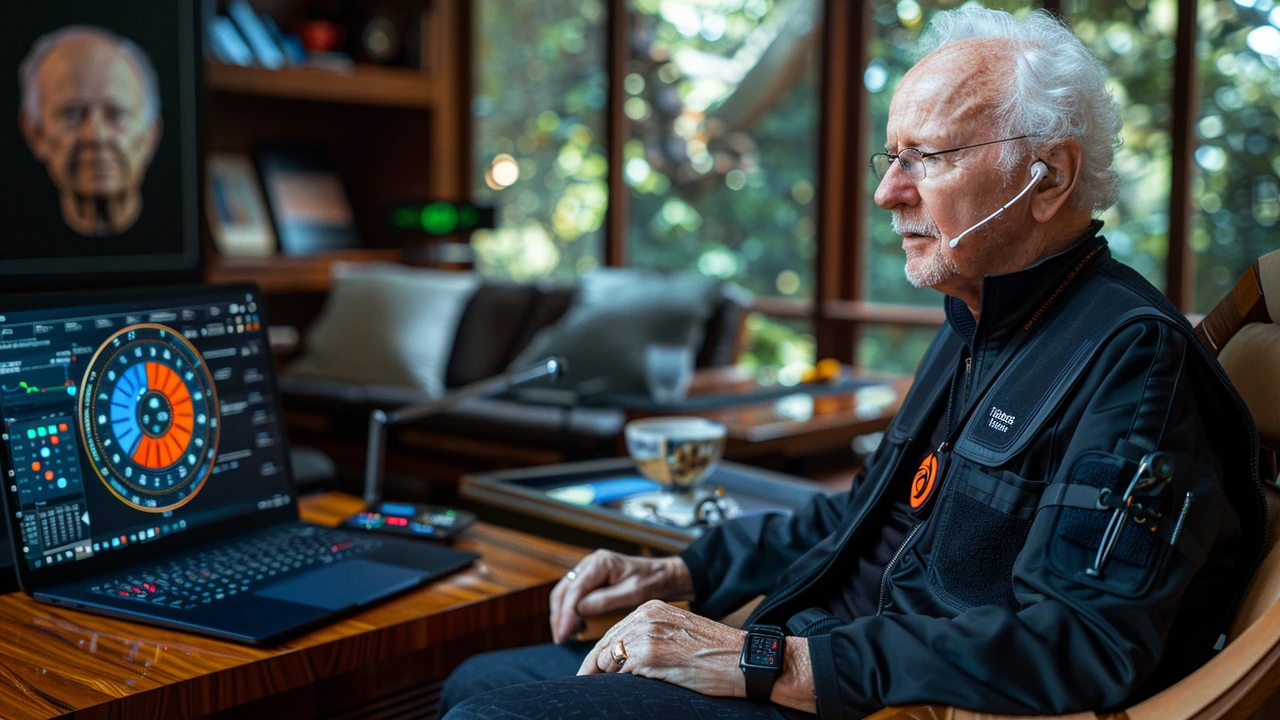
Biofeedback is making waves in the world of health and wellness. This innovative approach helps people gain control over certain physiological functions. By monitoring real-time data on things like heart rate, individuals can make adjustments to improve their health. This is especially useful for heart health, where managing stress and other factors can have a significant impact.
The principle behind biofeedback is simple. Sensors attached to the body provide feedback on physiological activities, translating this information into visual or auditory cues. This immediate response allows people to learn how to control processes that were once thought to be automatic. From managing heart rate to reducing stress levels, biofeedback holds great promise for those aiming for better heart health.
- Understanding Biofeedback
- How Biofeedback Improves Heart Health
- Types of Biofeedback Techniques
- Real-Life Success Stories
- Tips for Practicing Biofeedback at Home
Understanding Biofeedback
Biofeedback is not just a fancy term tossed around in wellness circles; it's a scientifically-backed method that empowers individuals to control bodily functions that are typically involuntary. At its core, biofeedback leverages technology to provide real-time data on physiological processes. This might include heart rate, muscle tension, skin temperature, blood flow, and even brainwave patterns. The beauty of biofeedback is that it converts this data into visual or auditory signals, allowing individuals to make necessary adjustments immediately.
Think about it: When you look about how the heart beats, it's often beyond your conscious control, except when exercising or during moments of intense emotion. Through biofeedback, persons can learn to regulate their heart rate deliberately, which is incredibly useful for managing conditions like hypertension or anxiety.
"Biofeedback allows us to 'see' what's happening inside our bodies so that we can systematically learn to make changes," says Dr. Frank Andrasik, a renowned expert in the field.
There are several types of biofeedback, each targeting different physiological processes. For heart health specifically, Heart Rate Variability (HRV) training is prevalent. HRV measures the variation between each heartbeat, which is an excellent indicator of how well the heart responds to stress. Higher variability generally means better cardiovascular health. By monitoring HRV, individuals can practice techniques like deep breathing or mindfulness meditation to positively impact their heart health.
Other common methods include Electromyography (EMG) biofeedback, which measures muscle tension, and Thermal biofeedback that provides data on skin temperature, an indirect measure of blood flow. Both of these are also useful in managing stress and anxiety, common precursors to heart issues. A simple session could involve placing sensors on the skin which feed data back to a computer or mobile device, making it accessible for just about anyone.
One fascinating aspect of biofeedback is how it integrates technology with traditional stress-management techniques. Imagine you are meditating. Biofeedback allows you to quantify how effective your mediation is in real time. For example, a guided meditation might show a calming blue light when your heart rate decreases or other positive feedback that can indicate your practices are effective. This layer of information helps finetune your approach to better heart health.
More exciting, the technology has become more user-friendly and accessible over the years. Devices like the Fitbit and Apple Watch have biofeedback-like features that can help regularly monitor some vital stats. While these may not provide the depth of data that's available in a clinical setting, they are handy tools for everyday awareness and management of heart health.

How Biofeedback Improves Heart Health
Biofeedback serves as a powerful tool in the management and improvement of heart health. By using sensors to measure physiological functions like heart rate, muscle tension, and skin temperature, biofeedback provides real-time information about how the body reacts to different situations. This information can be immensely valuable for those looking to make positive changes for their cardiovascular health.
The mind-body connection plays a crucial role in heart health. Stress, anxiety, and other emotional states can have a direct impact on heart rate and blood pressure. Biofeedback helps individuals recognize their stressors and how their bodies respond to them, offering a practical way to manage these responses. By practicing relaxation techniques in conjunction with biofeedback, people can learn to lower their heart rate and blood pressure, contributing to better heart health.
One particularly effective use of biofeedback for heart health is Heart Rate Variability (HRV) training. HRV is the variation in time between each heartbeat, and higher variability is generally associated with better cardiovascular fitness and stress resilience. Through biofeedback, individuals can monitor their HRV and practice techniques like deep breathing or meditation to improve it. A study conducted by the American Heart Association found that regular HRV training can lead to significant improvements in heart health.
According to Dr. Paul Lehrer, a clinical psychologist specializing in biofeedback, "Biofeedback helps individuals learn self-regulation techniques that reduce stress and improve overall cardiovascular function."
Biofeedback is not just about immediate responses; it provides lasting benefits. Over time, individuals who consistently use biofeedback can develop better autonomic control, meaning the unconscious processes that regulate heart rate and blood pressure become more balanced. This can lead to reduced risks of heart disease, hypertension, and other cardiovascular issues.
In addition to HRV training, there are other biofeedback methods that can help with heart health. For example, Electromyography (EMG) biofeedback focuses on reducing muscle tension, which can also positively affect the heart. Sensors placed on certain muscle groups help individuals become aware of unnecessary tension and train them to relax. This relaxation, in turn, reduces strain on the heart, promoting better cardiovascular function.
Let’s not forget the importance of consistent practice. While the benefits of biofeedback can be seen in as little as one session, long-term commitment brings the most significant rewards. Regular biofeedback practice reinforces healthy habits and ensures that the positive changes in heart health are maintained over time. Carrying out daily or weekly sessions helps solidify the techniques learned and provides ongoing motivation to stick with a heart-healthy lifestyle.
The implementation of biofeedback is quite user-friendly as well. With advancements in technology, many biofeedback devices are now available for home use, making it accessible to a broader audience. These devices range from wearable gadgets to smartphone apps, allowing individuals to practice biofeedback techniques in the comfort of their own homes and at their own pace.
The flexibility of biofeedback training means it can fit into any lifestyle. Whether someone has five minutes or an hour to spare, they can engage in biofeedback exercises. By integrating these practices into daily routines, individuals can see continuous improvements in their heart health.

Real-Life Success Stories
One of the most compelling aspects of biofeedback is how it has profoundly changed lives. Let's dive into some real-life stories that illustrate the power of this technique. Take John, a 55-year-old man from Ohio. He had always struggled with hypertension and tried multiple medications and lifestyle changes, but nothing seemed to provide lasting results. Introduced to biofeedback by his cardiologist, John started seeing remarkable changes within just a few months. By learning to control his heart rate and stress levels, he managed to lower his blood pressure, reducing his need for medication. Today, John is a strong advocate for incorporating biofeedback in heart health management.
Another powerful story comes from Maria, a 40-year-old woman dealing with severe anxiety. The anxiety was not only affecting her mental well-being but also her heart health, causing dangerous fluctuations in her heart rate. Maria’s therapist suggested biofeedback as a complementary approach. Slowly but surely, biofeedback sessions helped her understand how her body responds to stress and how she can control her heart rate through relaxation techniques. Maria's story highlights not just an improvement in heart health, but a boost in overall quality of life.
Perhaps one of the most remarkable examples comes from a study conducted at the Cleveland Clinic, where a group of patients with chronic heart failure participated in biofeedback sessions. Over six months, the patients who engaged in biofeedback showed substantial improvements in heart function and stress reduction compared to a control group. These measurable benefits underline the potential of biofeedback for serious heart conditions.
Quote:
"Biofeedback is not just a treatment; it’s a learning process. People are often amazed at how much control they can regain over their bodies," says Dr. James Carter, a renowned cardiologist.These stories share a common thread: the transformative power of biofeedback. As more people become aware of this approach, the hope is that biofeedback will become a standard part of heart health management, offering life-changing benefits to many.

Tips for Practicing Biofeedback at Home
Practicing biofeedback at home can be a game-changer for improving your heart health. With the right tools and techniques, you can effectively monitor and control your heart rate, stress levels, and more. Here's how to get started.
Choose the Right Equipment
First, it’s important to get the right equipment. Many devices on the market cater to home biofeedback. These range from simple wearables like heart rate monitors to more sophisticated gadgets that track multiple metrics. Some popular and reliable devices include the Fitbit, Apple Watch, and HeartMath Inner Balance. These gadgets provide real-time data on your physiological activities, helping you make necessary adjustments.
Heart health can significantly improve with the right equipment. Remember to check reviews and consult healthcare professionals if you’re uncertain about which gadget to choose.
Set Up a Comfortable Space
A comfortable and quiet space is essential for effective biofeedback practice. Choose a room where you can relax without interruptions. This space should be free from distractions like phone alerts and household noise. A comfortable chair and proper lighting can also make a big difference. It's helpful to practice at the same time each day, turning it into a routine.
Learn Relaxation Techniques
Biofeedback often involves relaxation techniques such as deep breathing, meditation, and progressive muscle relaxation. Deep breathing exercises are particularly useful for calming the mind and lowering heart rate. Learning to focus on your breath and taking slow, steady breaths can help you gain control over your physiological responses. Beginners might find guided meditation apps useful for getting started.
“Biofeedback provides a window into the body's functioning and helps people learn how to regulate bodily responses that were once thought to be out of their control.” – National Institute of Mental Health
Track Your Progress
Keeping a journal to track your progress can be incredibly motivating. Record your measurements, note any changes you observe, and reflect on how you feel. This can help you identify patterns and trigger points that influence your heart health. Over time, you'll be able to see clear progress, which can be very encouraging.
Be Consistent
Consistency is key to seeing results from biofeedback. Making it a part of your daily routine will ensure that you get the most benefit. Set aside at least 20-30 minutes each day for your practice. It might be challenging at first, but the more you do it, the more natural it will become. Consistent practice will help you gain better control over your heart health.
Seek Professional Guidance
While home practice is beneficial, seeking guidance from a qualified biofeedback therapist can provide additional benefits. They can offer personalized advice, teach you advanced techniques, and ensure you’re using your equipment correctly. Professional sessions can also serve as benchmarks for your at-home efforts, helping you fine-tune your practice for maximum effectiveness.
In summary, practicing biofeedback at home is a powerful way to improve heart health. With the right equipment, a comfortable space, and consistent practice, you can learn to control your heart rate and reduce stress. Don't forget to track your progress and seek professional guidance when needed. Your heart will thank you.
